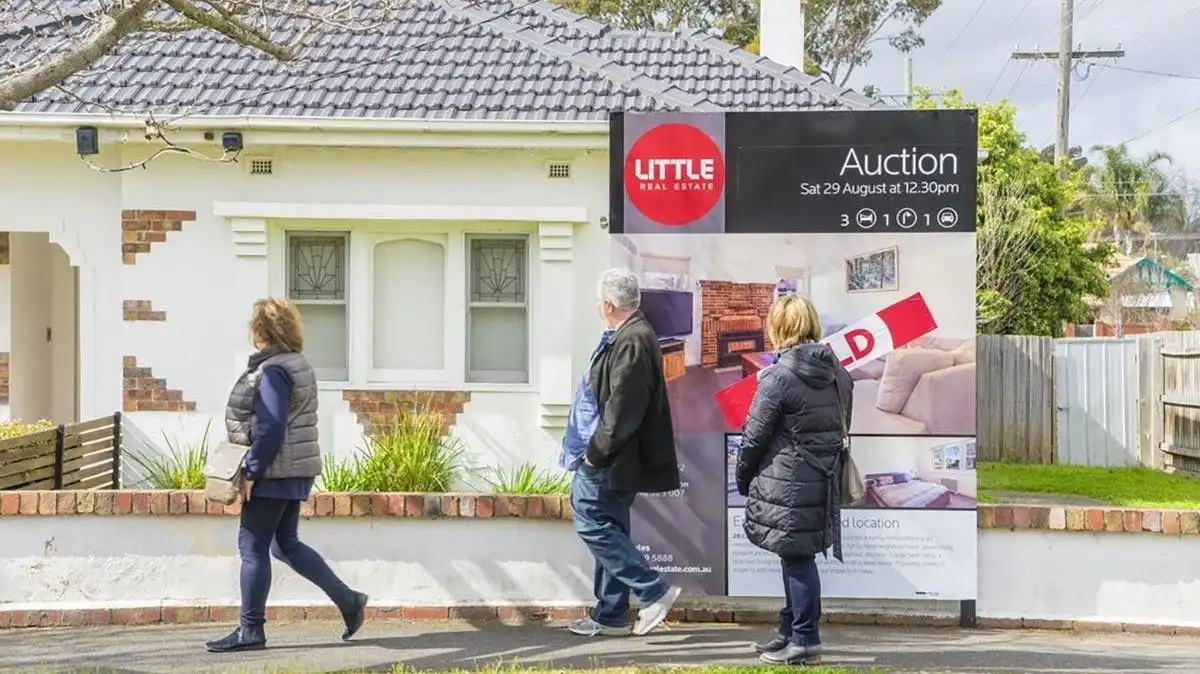Property market hits turning point as Sydney prices drop, other cities stall
For the first time in 17 months, Sydney's median property price has fallen, and all other capital cities have cooled since last month according to CoreLogic's latest data.
New listings are broadly on the rise, inflation and interest rate hikes are a hot topic, and the upcoming federal election could shake the market up.
What does it all mean for sellers in 2022? Find out in our February national market update.
National property values: February 2022
Houses$791,412Monthly change: +0.7%
Units$609,759Monthly change: +0.3%
The median Australian home rose in value by +0.6 per cent last month, a long way from the March 2021 peak of +2.8 per cent.
Month-on-month growth slowed in nearly every capital city in February. It was the lowest rate of national monthly growth since October 2020, with the country's two biggest markets coming to a price standstill.
| Market | Month | Quarter | Annual | Median value |
|---|---|---|---|---|
| Sydney | -0.1% | 0.8% | 22.4% | $1,116,219 |
| Melbourne | 0.0% | 0.2% | 12.5% | $799,756 |
| Brisbane | 1.8% | 7.2% | 29.7% | $722,433 |
| Adelaide | 1.5% | 6.4% | 25.8% | $593,883 |
| Perth | 0.3% | 1.3% | 8.6% | $535,335 |
| Hobart | 1.2% | 3.5% | 26.0% | $724,366 |
| Darwin | 0.4% | 1.5% | 12.3% | $495,573 |
| Canberra | 0.4% | 3.1% | 23.8% | $909,379 |
| Combined capitals | 0.3% | 1.8% | 19.2% | $808,792 |
| Combined regional | 1.6% | 5.7% | 25.5% | $564,496 |
| Australia | 0.6% | 2.7% | 20.6% | $728,034 |
Slight as it was, Sydney's fall of -0.1 per cent was the first time the city had seen a price dip since September 2020, while Melbourne prices remained unchanged and just +0.2 per cent up for the quarter.
Brisbane and Adelaide, which have been surging again in recent months, also saw a reduction in growth but still delivered strong results.
Canberra also underperformed compared to previous months, as did Perth and Darwin which have experienced only moderate increases since mid-way through 2021.
Hobart was the only capital city to maintain the same level of monthly growth, turning in another solid +1.2 per cent gain.
Once again, regional markets strongly outperformed the capitals, with regional SA, Queensland and Tasmania delivering the standout results for February.
On a national level, it's the first time in 11 months that the annual growth metric has dipped. Annual gains peaked at +22.4 per cent in January. That's now down to +20.6 per cent for the year.
More choice for buyers is turning the tables
One of the key factors driving the slowdown is an increase in available stock on the market.
On a national level, total listings are still -32.1 per cent below the five-year average, but that number has been shrinking as new listings are on the rise.
For Sydney and Melbourne in particular, total supply levels have returned to what CoreLogic calls "more normal levels," which is playing a big part in growth easing in those two markets.
That's not the case in some other cities, though, as a shortage of housing stock still isn't able to meet high buyer demand.
"The cities where housing values are rising more rapidly continue to show a clear lack of available properties to purchase," CoreLogic's head of research Australia Tim Lawless explained.
"Total listings across Brisbane and Adelaide remain more than 20 per cent lower than a year ago and more than 40% below the previous five-year average."
"Similarly, the combined rest-of-state markets continue to see low advertised supply, 24.9 per cent below last year and almost 45% below the five-year average."
The report notes that, on top of the increase in new listings in Sydney and Melbourne, demand is also softening due to affordability pressures, higher mortgage rates and a general decline in consumer sentiment.
As new listings rise and total stock on the market approaches normal or above-average levels, the balance of power is likely to shift in the direction of buyers. For now, though, the data seems to show that sellers still have the upper hand.
Regions maintain solid but slowing growth
Australia's regional markets have strongly outperformed the capital city markets once again, drawing gains of +1.6 per cent.
| Market | Month | Quarter | Annual | Median value |
|---|---|---|---|---|
| Regional NSW | 1.5% | 5.7% | 29.3% | $714,900 |
| Regional VIC | 1.2% | 4.7% | 22.3% | $572,958 |
| Regional QLD | 1.9% | 6.4% | 25.7% | $519,824 |
| Regional SA | 2.3% | 6.8% | 17.1% | $308,688 |
| Regional WA | 0.5% | 2.9% | 10.9% | $388,029 |
| Regional TAS | 1.9% | 5.7% | 28.9% | $507,282 |
| Combined capitals | 0.3% | 1.8% | 19.2% | $808,792 |
| Combined regional | 1.6% | 5.7% | 25.5% | $564,496 |
SA, Queensland and Tasmania saw the highest rates of growth for the month, with regional WA the only market to dip below the +1.0 per cent mark.
CoreLogic's recent regional market update outlined the remarkable surge over the past 18 months in coastal markets especially, but some of the forces slowing growth in the cities are also beginning to creep in elsewhere.
“Regional housing markets aren’t immune from the higher cost of debt as fixed-term mortgage rates rise," Mr Lawless said.
"These markets are also increasingly impacted by worsening affordability constraints as housing prices consistently outpace incomes."
"However, demographic tailwinds, low inventory levels and ongoing demand for coastal or treechange housing options are continuing to support strong upwards price pressures across regional housing markets."
Ultimately, the regional markets are still exhibiting strong conditions for sellers. That may change as 2022 unfolds.
A tight rental market and open borders could entice investors
Last month, SQM Research reported that rental vacancy rates around the country had hit a 16-year low of just 1.3 per cent.
SQM's managing director Louis Christopher said "this represents an acute shortage of rental properties, and the shortage has already been translating into large surges in weekly rents across the country."
| Market | Jan 2021 vacancies | Jan 2021 vacancy rate | Jan 2022 vacancies | Jan 2022 vacancy rate |
|---|---|---|---|---|
| Sydney | 24,309 | 3.2% | 16,357 | 2.1% |
| Melbourne | 27,432 | 4.4% | 17,112 | 2.7% |
| Brisbane | 5,886 | 1.7% | 3,878 | 1.1% |
| Perth | 1,808 | 0.8% | 1,285 | 0.6% |
| Adelaide | 1,405 | 0.7% | 819 | 0.4% |
| Canberra | 579 | 0.8% | 489 | 0.7% |
| Darwin | 262 | 0.8% | 306 | 0.9% |
| Hobart | 192 | 0.6% | 86 | 0.3% |
| National | 71,303 | 2.0% | 47,977 | 1.3% |
Mr Lawless explains that a rise in rental returns is being led by Sydney and Melbourne, where vacancies have dropped substantially.
"Anecdotally, demand for unit rentals in these cities has been bolstered by a combination of worsening rental affordability deflecting more demand towards the higher density sector, where rents tend to be lower, and demand starting to return from overseas arrivals," he said.
Australia's international border is now reopened to the rest of the world, so there should be a new wave of demand for housing, particularly rental accommodation, which could see vacancy rates fall even lower while rental returns are pushed up.
With the sale price of properties now slowing, this could mean that gross rental yields now begin to rise, which may tempt more investors to return the market. That's particularly good news for any sellers holding an investment-grade property.
What's next for the Australian property market?
CoreLogic's report points out that, since March 2020, the median Australian property price has risen by +24.6 per cent, or around $144,000.
That's been driven by factors like record-low interest rates, rising household savings through lockdowns, an imbalance in supply and demand, government stimulus and strong consumer sentiment towards housing.
As they put it, "each of these factors are losing their potency to drive housing values higher."
With interest rates tipped to rise, listings on the up, housing affordability pushed to the limit and sentiment on the decline, we may have passed through the period of peak selling conditions.
"With rising global uncertainty and the potential for weaker consumer sentiment amidst tighter monetary policy settings, the downside risk for housing markets has become more pronounced in recent months," Mr Lawless said.
On the upside, Australia's economy is still strong, and more travel activity—both international and domestic—should increase demand for housing, which will have a positive impact on price growth.
Last month, Ray White TNG's Shiv Nair told OpenAgent "I believe we are now entering into the next cycle of the property market. We have seen such high growth in the past 12 months, and the market is just levelling out at this moment.
"If anyone is thinking of selling, this current market is definitely the market I would be selling in."








